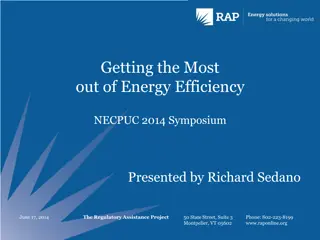Understanding the Rebound Effect in Energy Efficiency: Implications and Considerations
The rebound effect in energy efficiency refers to the phenomenon where energy savings from efficiency improvements are partially offset by increased usage or spending elsewhere. This comprehensive study delves into the direct and indirect rebound effects, scales of impact, reasons why promised savings aren't always realized, and the role of policies in addressing rebound. Through examples and data, it explores the complexities of the rebound effect and its significance in sustainability efforts.
Download Presentation

Please find below an Image/Link to download the presentation.
The content on the website is provided AS IS for your information and personal use only. It may not be sold, licensed, or shared on other websites without obtaining consent from the author. Download presentation by click this link. If you encounter any issues during the download, it is possible that the publisher has removed the file from their server.
E N D
Presentation Transcript
Environmental Change Institute The Rebound Effect Tina Fawcett
Outline What is the rebound effect? Scale of the direct rebound effect Other reasons energy efficiency does not always deliver promised savings Arguments about the indirect rebound effect Policy and rebound What are arguments about rebound really about? Conclusions
Varieties of rebound effect Direct rebound effect users taking advantage of the new lower price of the energy service to use more of that service (typical example is having a warmer home after efficiency improvements). Can be measured (up to a point). Indirect rebound effect money saved as a result of energy savings is spent elsewhere in the economy on goods / services which have embodied energy. Can be modelled Economy wide effect the fall in service cost reduces the price of other goods, creates new production possibilities and increases economic growth. Debate as to whether it can be modelled.
Scale of the direct rebound effect Estimated as 5-15% for UK residential energy Chitnis et al. (2013) Rebound effects are generally less than 10 percent, and unlikely to exceed 60 percent. Gillingham et al (2016) For the energy end uses for which studies are available, the range of estimates for the size of the rebound effect is very low to moderate. Greening et al. (2000) For household energy services in the OECD, the direct rebound effect should generally be less than 30% Sorrell et al. (2009)
Other reasons energy efficiency does not always deliver promised savings efficiency not as high in reality as reported via the energy label / test standards users are not enabled to use the new thing correctly (wasting energy, rather than getting additional energy services) the efficient technology is installed badly, and/or controls and systems are poorly designed the wrong baseline assumption about energy use before the intervention.
Why does the rebound effect involve so much air travel? An example of a rebound effect would be a family that insulates their loft and puts the money saved on their heating bill towards an overseas holiday. UKERC website promoting Steve Sorrell s 2007 report A good example of a rebound effect would be an individual deciding to treat themselves to a foreign holiday with the money they had saved on the energy bill through insulation measures Corner and Clarke, 2017:76
The indirect rebound effect LEDs into flights High carbon Money available to spend on other things Zero / low cost Average carbon Low / -ve carbon Energy efficiency investment High carbon Money removed from expenditure High cost Average carbon Low / -ve carbon
Moral licensing a possible mechanism? Moral licensing theory suggests that past good deeds can liberate individuals to engage in behaviors that are immoral, unethical, or otherwise problematic, behaviors that they would otherwise avoid for fear of feeling or appearing immoral . (Blanken et al, 2015) Blanken et al (2015) conducted a meta- analysis of 91 studies of moral licensing. Most studies in the meta-analysis looked at choices or intentions around volunteering / charitable donations, honesty with money, and racial prejudice. No studies related to energy / energy efficiency. They concluded that the magnitude of the moral licensing effect is lower than typical effects in social psychology.
The reverse rebound effect High carbon Money available to spend on other things Zero / low cost Average carbon Low / -ve carbon Energy efficiency investment Excess spending on solid wall insulation into avoided flights High carbon Money removed from expenditure High cost Average carbon Low / -ve carbon I have spent more on home insulation than will pay back through energy savings. Estimate this equates to about 30 return flights to New York = 2x 25years of carbon saving from heating energy savings (measured).
The rebound effect & policy The debate about the magnitude of the rebound effect continues and has important implications for energy efficiency policy. Gillingham et al., 2016 Examples of inclusion in policy: Energy savings reduced by In Use Factor in UK energy company obligation schemes, varies with technology & includes rebound Ireland assumes a rebound effect of 70% associated with the comfort taking effect in low-income households U.S. Department of Energy includes a 10% rebound effect from car standards into its energy forecasting Font Vivanco et al, 2016
What are rebound effect arguments really about? (1) Some of the commentary on the rebound effect is mischievous or misguided. Making lighting more efficient could increase energy use, not decrease it A desire to report the counterintuitive could stem from different impulses - for example, a legitimate wish to highlight contradictions in public policy, or, more negatively, the search for stories that justify adhering to damaging choices and behaviours.
Yes, but the wind doesnt blow all the time you know .
What are rebound effect arguments really about? (2) Rowson (2013) suggests that in the absence of clear evidence, disagreement about the size of the rebound effect looks like a proxy war for deeper ideological conflicts
Concluding thoughts In some cases, the rebound effect is significant in scale and should be incorporated in policy designs; in other cases it is very minor, and a distraction. Given the incomplete evidence base, telling the difference isn t always easy. The scale of rebound is likely to change over time probably reducing, particularly with more expensive low carbon interventions. Understanding energy demand in its full socio-technical context, in addition to its economic context, should help build more robust policy. And finally, there is no evidence to suggest that people are converting savings from light bulbs or insulation into flights.
The rebound effect is rather like the Loch Ness monster a mythical beast that reappears from time to time. paraphrasing Lee Schipper, Energy Policy























